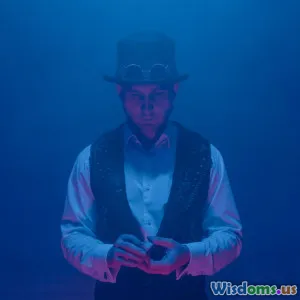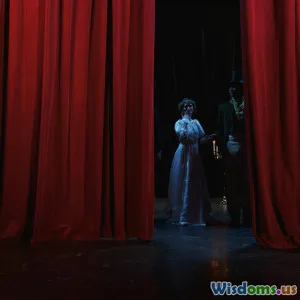
Hidden Camera Reveals How Audiences React to Magic Tricks
7 min read Hidden cameras unlock the fascinating ways audiences genuinely react to mesmerizing magic tricks. (0 Reviews)
Hidden Camera Reveals How Audiences React to Magic Tricks
Magic is an art form built on awe, wonder, and the delightful suspension of disbelief. But what truly happens when spectators watch a magician pull off an impossible feat? Thanks to hidden camera technology, we now have unprecedented access to genuine audience reactions—providing deep insights into what makes magic so mesmerizing.
The Allure of Authentic Reactions
Watching a live magic show evokes a mix of emotions: disbelief, surprise, joy, and sometimes even bafflement. Yet traditional videos and rehearsed performances often fail to capture the full spectrum of these responses. Hidden cameras, cleverly positioned during live performances, capture candid, unfiltered reactions from audiences.
This raw footage is pure gold, revealing subtle gestures, jaw drops, smiles, gasps, and even moments of incredulous laughter. For example, in a viral clip of a street magician performing card tricks, hidden cameras caught strangers’ shocked expressions and spontaneous applause before the magician even had a chance to acknowledge them.
Psychological Insights from Hidden Camera Footage
The Surprise Element
One thing these hidden recordings consistently highlight is the power of surprise. When the outcome defies expectations, viewers' faces register a fleeting moment of confusion, followed by delight or astonishment. Psychologists suggest that this emotional rollercoaster underpins the human brain's thrill with magic—our mental schema is challenged, creating enhanced engagement.
The Mirror Effect
Interestingly, audience members often react together in a synchronized way. Hidden cameras show groups gasping simultaneously or exchanging amused glances. This reflects a social cognition phenomenon called emotional contagion; people’s feelings tend to synchronize in communal settings, amplifying the experience.
Engagement vs. Skepticism
Hidden camera clips with various groups demonstrate a spectrum of reactions—some audiences embrace the magic with childlike enthusiasm, while others display subtle skepticism, scrutinizing the magician’s every move. These divergent responses underscore how prior beliefs, cultural background, and personality traits impact the experience of magic.
Notable Examples of Hidden Camera Magic Experiments
David Blaine’s Street Magic Experiments
World-renowned magician David Blaine is famous for insightful street magic clips caught on hidden cameras. By performing up-close magic in spontaneous environments, the elusive realism of spectators’ reactions is preserved. For example, in one video, a passerby who initially looks doubtful visibly leans forward, eyes wide, captivated by a seemingly impossible levitation trick.
The Science Behind Magic With Apollo Robbins
Considered the world’s greatest pickpocket, Apollo Robbins has been studied through hidden footage to analyze not just his skill but audience reactions. His tricks provoke not just amazement but also heightened awareness and surprise, serving as an example of how magic engages both the cognitive and emotional brain centers.
Why Hidden Camera Reactions Matter to Magicians
Refining Performance Techniques
Real audience behavior, as captured on hidden cameras, provides magicians with valuable feedback on which illusions evoke the strongest reactions. This allows performers to refine timing, patter, and theatrical elements to build a more immersive atmosphere.
Enhancing Audience Engagement
Understanding reactions helps magicians craft experiences that maximize emotional impact. For instance, noticing that subtle expressions of bewilderment precede a big smile enables performers to hold suspense longer for greater payoff.
Preserving the Mystery
The genuine reactions caught by hidden cameras reinforce why the magician’s secrecy and surprise are essential to the craft. Revealing the trick too soon or capturing staged reactions diminishes the magic, but hidden cameras protect authenticity without spoiling the show.
Broader Implications: What Magic Teaches Us About Human Nature
Magic is, at its core, a study in perception and cognition. Hidden camera footage teaches us how finely tuned humans are to expect certain realities—and how easily those expectations can be subverted.
These videos underscore the joy we derive from witnessing anomalies that disrupt normal logic, hinting at a deep-seated desire for mystery and wonder in everyday life.
Conclusion: The Invisible Lens Enhancing Magic’s Impact
Invisible surveillance technology has opened a window into the human soul at moments of amazement. Thanks to hidden cameras, we can better understand the complexity, spontaneity, and emotional richness of audience reactions to magic tricks. For magicians, psychologists, and fans alike, these candid reactions are invaluable.
They remind us that magic is not just about the illusion itself, but the shared human experience it creates—an experience of wonder that transcends age, culture, and skepticism.
As technology continues to evolve, so will our ability to capture and appreciate these fleeting moments of pure magic, deepening the connection between performer and audience in ever more immersive ways.
References:
- Blakeslee, S., & Blakeslee, M. (2007). The Body Has a Mind of Its Own. Discovering the brain's role in perception and belief.
- Kuhn, G., Amlani, A. A., & Rensink, R. A. (2008). "Towards a science of magic." Trends in Cognitive Sciences.
- Apollo Robbins’ TED Talk on perception and misdirection. TED.com
- Street magic videos by David Blaine (various online archives).
Rate the Post
User Reviews
Popular Posts




















